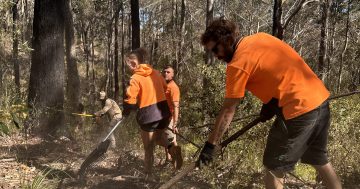
The Beachwatch Partnership Program monitored the water quality of 11 beaches across the Eurobodalla Shire Council area. Photo: ESC.
When heading to the beach for the weekend or a holiday, the last thing you probably want to do is dive into water contaminated by faecal matter.
But according to the latest Beachwatch report, you could be doing just that at two beaches in the Batemans Bay region.
The State of the Beaches 2021-22 water quality report, which covered 214 swimming locations across the state, graded Surf Beach and Caseys Beach as ”poor” due to elevated bacterial levels during both dry and wet weather.
They were two of seven beaches that received the rating across NSW.
“Microbial water quality at these beaches has continued to decline for several years, with the microbial water quality at Caseys Beach crossing the threshold from Good to Poor,” the report stated.
The program monitored for levels of enterococci, the single preferred faecal indicator in marine waters across Australia.
The grades were determined from the most recent 100 water quality results, which spanned two to four years depending on how often samples were collected.
A ”Poor” grade meant the location was susceptible to faecal pollution, which meant the microbial water quality was not always suitable for swimming.
“During dry weather conditions, ensure that the swimming location is free of signs of pollution, such as discoloured water, odour or debris in the water,” the report recommended.
“Avoid swimming at all times during and for up to three days following rainfall.”
Eurobodalla Shire Council was already looking into where the contamination of Surf Beach was coming from, with sampling undertaken at the beach and the adjoining Wimbie and Denhams beaches.
However, a council spokesperson said a potential source of Surf Beach’s continued water quality issues still hadn’t been identified.
“Overall water quality is generally poorer after rainfall, however, poor results have also been observed when no recent rainfall has been recorded,” the spokesperson said.
They confirmed a similar investigation had begun for Caseys Beach, with a sampling program developed for the Caseys Beach catchment.
“In general, the main impacts on water quality are due to stormwater runoff and disturbances in the catchment,” the spokesperson said.
“The Eurobodalla has experienced three consecutive years of above-average rainfall and the associated stormwater runoff is considered to be the most likely cause for the decline in water quality at Caseys Beach.”
Comparisons with rainfall data, stormwater flow and creek flows formed part of these investigations. All available data from the Beachwatch samples would also be reviewed.
“The contamination could be from animals – enterococci are bacteria that are present in the gut of warm-blooded animals, including humans, birds, dogs, cats, etc – and as such is used as an indicator organism for potential faecal contamination,” the spokesperson said.
“The source of potential faecal contamination cannot be determined from this analysis.”
Samples were taken weekly from both beaches, and the council would post warning signs if water quality “trigger” values were exceeded.
The spokesperson said it was still safe to swim at these beaches.
All of the other monitored recreational waterways in the council area were rated ”Good” or ”Very good”.

Beach suitability grades for monitored beaches in the Eurobodalla Shire Council area. Photo: Beachwatch State of the Beaches 2021-22 report.
The report pointed out rainfall was a “major driver” of pollution to recreational waters, which generated stormwater runoff and triggered untreated discharges from wastewater treatment and transport systems.
Rainfall over the past two to four years varied for the South Coast, with average to below-average rainfall for winter 2021, followed by a very wet November. The state then experienced its wettest summer since 2011-2012, with areas on the South Coast receiving record rainfall.
March 2022 was also extremely wet along the entire NSW coast.
“All regions recorded from two to more than four times the long-term monthly average rainfall for March, with areas in Sydney and on the South Coast receiving their highest monthly rainfall for March on record,” the report stated.
Exposure to water contaminated with faecal material from animal and human sources could cause gastroenteritis, with sufferers experiencing vomiting, diarrhoea, stomach ache, nausea, headache and fever.
Eye, ear, skin and upper respiratory tract infections could also be contracted.
It was recommended swimming be avoided at any ocean beach during and for up to one day after rainfall, or if there were signs of stormwater pollution such as discoloured water, flowing stormwater drains or floating debris.
Eurobodalla Shire Council has been part of the Beachwatch Partnership Program since 2002.








